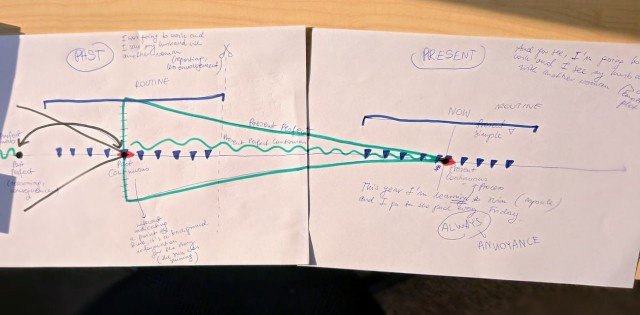How to revise grammar at C1 level?
How to revise basic grammar with a C1 student?
Well, the first question is: Does a C1 student even need such a revision?
I guess it all depends on the student and/or the teacher who feels there might be need for some revision in specific problematic areas. What if the trainer claims the student’s grammar is REALLY good, yet the student insists on having some revision because they feel they have issues.
That’s basically what happened to me the other week. It was a 1-2-1 class so I could design the lesson around the student.
Normally, I would take out some paper and go over time-lines, give examples, provide visual stimuli for specific contexts, provide conversation topics to address specific grammar concepts etc. That is how I support lower levels – examples, contexts, and of course fun (can’t have it otherwise with my sessions ;) )
This time, however, I decided to approach the topic differently and dust off a technique I haven’t used in a while. Namely, the you-tell-me approach. Why should I – the trainer - be explaining things to you? Why don’t you – the student – tell me how you understand specific concepts and I can simply verify your knowledge and give you tricky questions to check your judgement (aka the “gut feeling”).
I gave my student two blank A4 pieces of paper with “PAST” and “PRESENT” written on them. Then I told her to draw a time-line through both pages and asked her to draw how she understands specific concepts of grammar and explain them to me (in English, of course). If I wasn’t sure about something, I asked for clarification.
Why did this work?
First off, instead of imposing a specific graphic representation of typical grammar points (that we can find in books, online activities etc) I asked the student to tell me how she sees each point. That way she created notes for herself in a way that she understood best. She also became the trainer – explaining to me how each aspect worked in her own words.
Secondly, I realized that my visual way of depicting specific grammar points is not necessarily someone else’s way of seeing it. I had quite a few questions - e.g. why are routines represented as multiple triangles in a specific time frame? Why is “now” a point, but kind of squashed?
What’s more, the colors…. Her reasoning behind assigning specific colors to grammar points was uncanny:
BLUE – routines – very often mundane, every-day activities that might make us feel blue. Also “once in a blue moon” - a “routine” but happening rarely…
BLACK – for Past Perfect – because it describes something happening in the past but even earlier than originally mentioned – black the color or death, the cemetery – because it is extremely old.
Finally, the funnel - a way to connect the past with the present, and then the "wiggle" in the middle to express the continuous aspect…
I loved it! I loved her interpretation and the session itself: handing the student the reins - giving her control of the session.
Plan for the next session: put all that theory into practice - I'll ask specific questions about her life to make sure she can pinpoint specific events to grammar points. After all, this is what she wants and expects from me :)
What do you think about such “method”?

Congratulations @cwbrooch! You have completed the following achievement on the Steem blockchain and have been rewarded with new badge(s) :
You can view your badges on your Steem Board and compare to others on the Steem Ranking
If you no longer want to receive notifications, reply to this comment with the word
STOPDo not miss the last post from @steemitboard:
Vote for @Steemitboard as a witness to get one more award and increased upvotes!